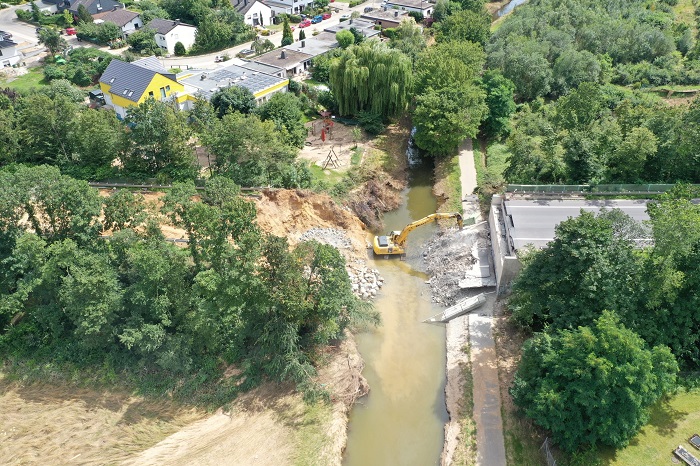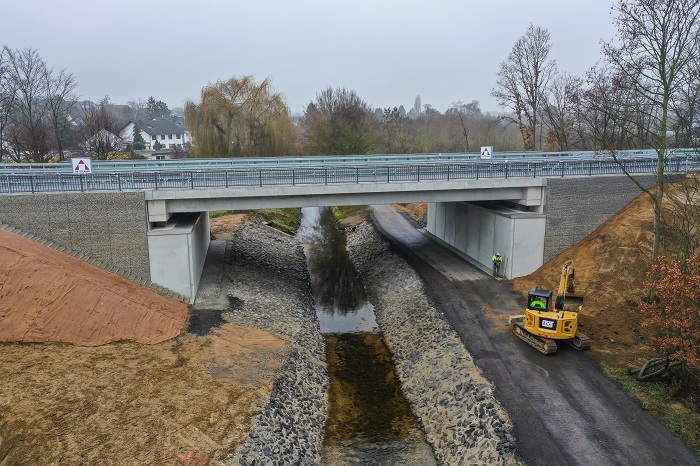The use of geogrid-reinforced earth allows reconstruction of a flood-destroyed German bridge in record time.

With the increase in extreme weather events worldwide because of climate change, such as those in July 2021 in Germany (in the states of North Rhine-Westphalia and Rhineland-Palatinate) and neighboring European countries, rapid and safe reconstruction methods are needed to ensure residents and businesses are not hampered long term by infrastructure damage.
During infrastructure reconstruction, geosynthetics can be used in many applications to ensure rapid construction progress. For example, urgently needed temporary utility roads, construction roads and work platforms can be quickly and safely constructed with geogrids or reinforcing mesh, even in very soft soils. Temporary storage of waste and contaminated sludge is also possible with geosynthetic contaminant barriers, filters and sludge-dewatering hoses to provide environmental protection from the effects of contaminants.
Flood reconstruction with geosynthetics of the Swistbach Bridge
The Swistbach Bridge in Heimerzheim, Germany (13 miles [21 km] east of Bonn), which carries the L182 highway over the Swistbach River, is one successful example of flood reconstruction with geosynthetics. Due to the destruction of the old bridge by the floods in July 2021, a completely rebuilt structure was necessary. After a record construction time of just three months, the new bridge was reopened to traffic in December 2021. The Swistbach Bridge has not only been built to be stable in the long term, it is also wider between abutments—by 13.84 feet (4.22 m)—thus, allowing the riverbed to pass under the bridge with extra space, making it better equipped for recurrent heavy rainfall events.
This realization was made possible by the innovative fast construction system by the Heitkamp BauHolding GmbH, which was developed together with HUESKER Synthetic GmbH: the Heitkamp Schnellbruecke system. The load-bearing columns of the system and the abutments are made of composite flexible geogrids and locally available soil. HUESKER provided the structural calculations for the abutments, alkali-resistant Fortrac geogrids and nonwoven geotextiles within a short timeframe.

Construction with geosynthetic-reinforced earth allows fast building of bridge abutments. Unlike in Germany, reinforced-earth structures have been among the standard construction methods used for most infrastructure projects in the Netherlands for a long time.
By using geogrid-and-earth construction, the construction time of the Swistbach Bridge abutments was reduced from three months to ten days. By using fewer resources and transporting fewer materials, CO2 emissions were reduced.
Sustainable and CO2-saving construction
Today, modern structures must be more than just economical and quick to build. In addition to stringent safety requirements, other factors such as sustainability play a significant role: Which materials are (re)used? What is the service life of the structure? How does it fit into its natural surroundings? It is not surprising, therefore, that solid construction methods are increasingly being replaced by alternative, more resource-efficient solutions, such as geosynthetics.
Where smooth concrete walls used to line canals, geotextiles are now used—where surface structures enable new habitats to settle, they can have a regulating effect on the flow properties of the canal or river. Dams and dikes are built in such a way that their surfaces can be overgrown and colonized by native grasses, thus blending into the landscape and ensuring maximum safety. Even erosion-proof spillways and stormwater retention basins for hazard reduction during heavy rainfall events are possible with geosynthetic building materials.
In comparison to conventional construction methods, build times can be shortened, a better environmental balance can be attained and higher longevity can be generated. The reduced use of building materials when geosynthetics are incorporated, such as concrete and asphalt, and the reusability of existing soils, conserves resources and requires less hauling. This also makes the construction process significantly faster.

 TEXTILES.ORG
TEXTILES.ORG


